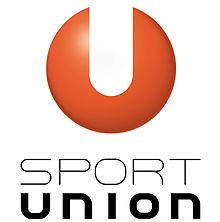Sports association
A sports association is an amalgamation of several clubs or associations of individual sports . In Germany , most sports associations are technically restricted to one type of sport (sports association, e.g. German Football Association ), which means that the "classic" sports club that offers several sports (multi-discipline club) can belong to several associations. Many associations have subdivided their nationwide umbrella organization into regional, state, district and district associations.
In addition to the structure of the professional associations, there are cross-sport associations, either those in which professional associations themselves can become members, e.g. B. the German Sports Confederation and its state sports federations , or those without subordinate professional associations (e.g. company sports associations). The tasks of the German Sports Confederation include a. to prevent the formation of a sport by "competing" professional associations (by non-acceptance).
Both clubs and other associations can become members of sports associations, but only rarely individual persons.
From a legal point of view, sports associations are mostly associations with legal capacity according to § 21 ff. BGB , which use the suffix e. V. lead.
Topics of the German sports associations
Depending on age and size, the individual sports associations had to deal with similar topics.
Founding and building an organization
After the establishment of a sports association, the association had to define the membership structure. Match operations and events had to be organized, as well as membership and participation in international associations.
Aryan decree / conformity 1933
After the seizure of power by the Nazis, the German sports associations were Reichsbund for physical education into line , d. In other words, there was only one association for each sport and the association area was identical to the area of responsibility of the administrative unit. The associations excluded Jewish members as early as 1933, although the official instruction that Jews should not be members of Aryan associations did not come until 1935. Only the Nuremberg Laws defined what a Jew was. This decree resulted in the "voluntary" resignation or emigration of many Jewish functionaries and athletes.
Union of Austria in 1938
After Austria was annexed to the German Reich in 1938, Austrian players and teams were integrated into German gaming operations.
Rebuilding after the end of the Second World War
During the Second World War , gaming operations mostly collapsed. After the end of the war, the associations had to be rebuilt and gaming operations reorganized.
advertising
The admissibility of advertising has always been an issue. For example, advertising at soccer matches was undesirable in the 1960s. If banners were displayed at a top game, the game was not televised. The advertising ban has been weakened over time.
Professionals, amateurs, transfer fees
In many sports, even the top players were officially considered amateurs for a long time. For example, only amateurs were allowed to take part in the Olympic Games. This amateur demand was dropped more and more. The sports associations also discussed the amount of transfer fees.
German reunification 1990
After reunification, the game had to be adjusted: the teams of the former GDR had to be integrated into the leagues.
Bosman decision 1995
The Bosman decision of December 15, 1995 states that athletes from EU countries are not considered foreigners within the EU area. This had an impact on the foreigner regulations that were valid until then, according to which, for example, only a maximum number of foreigners could be used in a team. The sports associations had to implement this judgment.
Sports associations in Austria
In addition to the various sports associations (such as the ÖFB ), there are three cross-sport umbrella sports associations in Austria.
ASKÖ
The Working Group for Sport and Physical Culture in Austria (ASKÖ) was founded in 1892 under the name "Workers' Association for Sport and Physical Culture in Austria" and is therefore the oldest umbrella organization in Austria. 1.1 million members are supported in around 4,400 clubs. According to the statutes, the ASKÖ is a preliminary organization of the SPÖ .
ASVÖ
The General Sports Association of Austria was founded in 1949. Unlike the other two umbrella organizations in Austria, the ASVÖ cannot be assigned to any political grouping; it sees itself as an independent and non-partisan pool for sports clubs. In 2005, the ASVÖ had around 5000 clubs with around one million members.
Sports union
The Sportunion was founded in 1889 as the Christian German Gymnastics Association as a spin-off from the Austrian Gymnastics Federation, and then re-established in 1945. It currently looks after around 4,238 clubs and sports groups with 1,103,526 members. Although it is independent of any party according to its own understanding, many functionaries are also closely associated with the ÖVP .
Associations in the USA
The United States Olympic Committee has the right by law ( Amateur Sports Act 1978) to market the Olympic rings and to send the Olympic team. From this derives only the right to guarantee fair Olympic eliminations, but not to be a monopoly association. In the non-Olympic sports the situation is noticeably fragmented because everyone has the right to found an association (like a club). So there are z. E.g. for powerlifting 18 (as of 2015) national associations, which all organize national championships for themselves, but each have different disciplines and forms of doping controls.
Individual evidence
- ^ Arnd Krüger : Sport and Politics. From gymnastics father Jahn to state amateur. Torch bearer, Hanover 1975 ISBN 3-7716-2087-2 .
- ↑ http://www.powerliftingtowin.com/powerlifting-federations/
See also: sport , association

